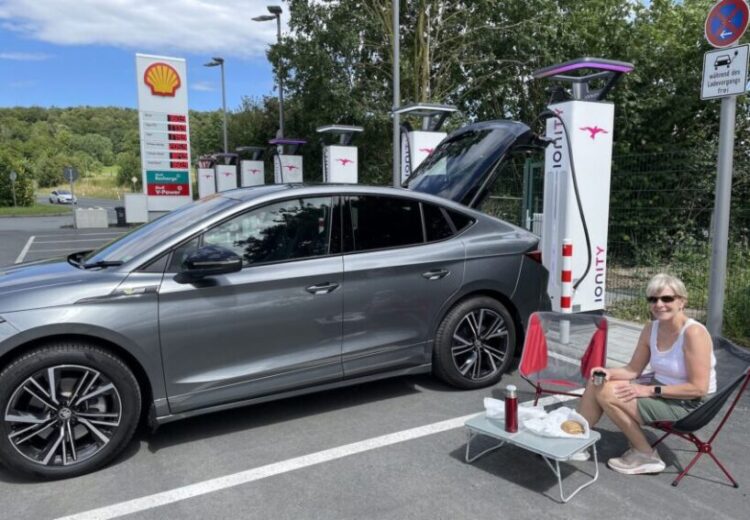
These EV driving hacks will make your Easter road-trip truly egg-cellent
The upcoming Easter bank holiday will see 19 million Easter road-trips carried out across UK roads, according to the latest figures provided by the RAC. This will make the upcoming period of Thursday (April 17), Good Friday (April 18), and Saturday (April 19), the busiest since 2022.
Over the course of the three days, 2.7 million Easter road-trips are expected to take place daily across the country. While journeys on Easter Sunday (April 20) will drop marginally to 2.5 million, figures will return to around the 2.7 mark on Easter Monday (April 21), ahead of the new school term beginning the following day.
Traffic analysis, INRIX, predict that Thursday, April 17 will be the businest day with 30% more traffic than usual. Its findings show that the worst delays are expected around 11:45 on the M25 anti-clockwise between Junction 7 (Gatwick) and Junction 16 (the M40). Tailbacks lasting over an hour are expected. Further north, the M6 north of Chester near Godstone is also expected to undergo heavy congestion.

On Good Friday, and the most congested times to travel are between 11:00 and 13:00. West Country routes in particular are set to be the most affected, with the A303 westbound near Stonehenge expected to undergo delays of around 45 minutes.
Moreover, Good Friday will see hold-ups of 1 hours 20 minutes on the M5 southbound between Junction 15 (RAC Tower) and Junction 23 (Bridgwater).
Fast-forward to Easter Monday, and severe delays yet again are expected in the West Country. The M5 northbound between Junction 25 (Taunton) and Junction 16 (RAC Tower) with congestion lasting up to around an hour. The M25 anti-clockwise between Junction 4 (Bromley) and the Darford Crossing will also experience lunchtime days above 30 minutes.
The following table outlines the best and worst times to travel over the Easter weekend.
| Date | Best times to travel | Worst times to travel |
| Thursday, April 17 | Before 12:00 (midday) | 14:00 – 19:00 |
| Friday, April 18 (Good Friday) | Before 10:00 | 10:00 – 17:00 |
| Saturday, April 19 | Before 10:30, after 14:00 | 11:00 – 13:00 |
| Sunday, April 20 (Easter Sunday) | After 13:00 | 11:00 – 13:00 |
| Monday, April 21 | Before 11:00 | 11:00 – 18:00 |
Unlike in previous years, there has been no information published for EV drivers planning an Easter 2025 getaway. Nonetheless, the EV Powered team has compiled a list of EV driving tips to make your Easter road-trip easier and more comfortable than ever.

Overnight charging before departure
If you have access to an EV home charger, charge your EV to the industry-recommended 80% the night before your Easter road-trip. Any more, and the additional electrons will place unnecessary stress on your battery in the long term. Alongside eliminating range anxiety, overnight EV charging will alleviate the stress of finding a charging station early on. Moreover, a home charger could save you a significant amount of money when it comes to charging your vehicle – certain home energy suppliers offer home charging rates from as little as 7p per-kilowatt hour.
Use a route planner such as ZapMap
The average range of an EV in the UK is 300 miles. This should be plenty to get you to your Easter EV road-trip destination. If, however, you are travelling further than your EV’s stated range, then consider using a route-planner such as Zapmap, which will build your journey around charging points along the way. Note that many newer EVs today have in-built infotainment systems capable of finding charging stations without the need for an app.
Avoid Peak Hours
As we outlined earlier, it’s advisable to avoid travelling during peak hours. This will result in a much calmer journey, as you will be less likely to get stuck in traffic jams. Should you need to top up your EV’s battery during your Easter road-trip, it is also worth remembering that charging stations during peak hours may be busier than normal. While uncommon in the UK, don’t forget that ‘charger rage’ is a thing. Begin your journey off-peak, and things will become easier for you and your fellow motorists.
Know your vehicle
Lke an ICE, an EV’s range is affected by terrain, how heavy you are with your right foot, and even the weather – the warmer it is, the better your battery will perform. If things are somewhat chilly, adverse temperatures will place extra stress on your battery. Ahead of setting off, familiarise yourself with the maximum charge your EV’s battery can take, and how long it will take to charge to 80% – doing this will help you plan addditional charging stops if needs be. Moreover, check what type of charger (Level 1, Level 2, Level 3) your EV is compatible with. Ultra-rapid chargers with speeds of over 150kW are the ideal choice for a quick splash ‘n dash. However, they may not work with older vehicles.

Drive efficiently
Driving efficiently can seriously help with eking out the most from your EV’s battery. We’d recommend driving in ‘Eco Mode’ – if possible – and using the vehicle’s momentum when travelling downhill to direct regenerated electricity to its battery. Regenerative braking is another way of doing this. However, if your regenerative braking settings is too strong, it can overstress the battery. The additional acceleration required to get your EV moving again may then result in less efficiency. Setting the cruise control to the speed limit – or even slightly lower – on motorways can also help you extract some all-important extra miles. Checking your vehicle’s ideal tyre pressures is another key part of ensuring you get the the best possible range from what you’re driving.
Take driving breaks strategically
Whether you drive an EV or an ICE, it’s common knowledge that we need to stop for a rest when driving long distances. Every two hours or so, be sure to stop to stretch your legs, take a comfort break, and fuel up on a drink and something to eat. Your EV may need some charge, too, so add some electrons if they’ll relieve some of that dreaded range anxiety. As such, try and plan your breaks around service stations and the likes.
Get online and ask questions!
Getting online and finding owners’ forums/groups dedicated to your EV can be a huge help when it comes to owner/vehicle bonding. If you have any queries about how your car will behave and what you can expect (both good and bad!) during a long-distance drive, get online to find out some first-hand user experiences!
Pack smart, pack light, and be prepared
The more a vehicle weighs, the less efficient it will be. EVs are no different. With that in mind, pack what you need if you’re concerned about range, and ask yourself whether you really need those four suitcases for a three day break. If you’re looking for a roof rack, find one of the more efficient options on the market to maximise your EV’s aerodynamics.





